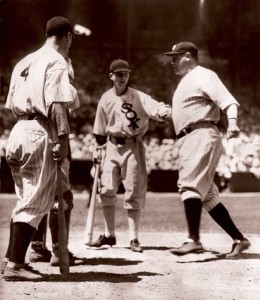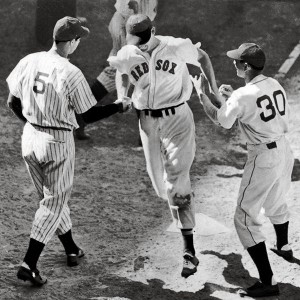Baseball All-Star Game Memories – Part 1, 1933-1959

Base Ruth hit the first home run in All-Star Game history.
Since its inception in 1933, the Major League Baseball All-Star Game has provided fans an annual opportunity to see most of the great stars of the game on the same field. While the game is an exhibition and has withstood periods of indifference by some players, management and fans, it remains a special mid-season moment.
There have been many memorable games and moments in the first 80 incarnations of the annual meeting between the top players of the American and National Leagues.
This is the first of a three-part series where we will relive some of the great moments and games in the history of this special series.
July 6, 1933 – Comiskey Park, Chicago
The idea of bringing the top players from both the American and National Leagues together in the middle of the season for one “All-Star” game was initiated by Arch Ward, a sports editor for the Chicago Tribune. The first game was played at Comiskey Park to coincide with Chicago’s Century of Progress Exposition.
In a fitting testimonial to his legendary career, Babe Ruth hit the first home run in All-Star history when he lifted a pitch from Bill Hallahan into the right-field stands in the third inning.
The American League went on to win the game 4-2 with Lefty Gomez earning the victory.
July 10, 1934 – Polo Grounds, New York City
Though the American League scored six runs in the fifth inning and held on for a 9-7 victory, this game is best remembered for the amazing pitching performance of a National League left-handed hurler.
When Carl Hubbell surrendered a hit and a walk to the first two American League batters in the opening inning of the game, it looked like the Junior Circuit was going to jump out to a big early lead. After all, the next three batters were all-time great sluggers Babe Ruth, Lou Gehrig and Jimmie Foxx.
However, Hubbell settled down and mowed down all three batters on strikes. He opened the second inning by increasing his streak of strikeouts of future Hall of Famers to five when he struck out Al Simmons and Joe Cronin.
July 11, 1939 – Yankee Stadium, New York City
It was fitting that in the first All-Star Game played at Yankee Stadium, New York great Joe DiMaggio would provide the fireworks. His solo home run in the fifth inning gave the American League a 3-1 lead and they would hold on for the victory.
The game was particularly memorable because 20-year old Bob Feller made his All-Star debut and allowed only one hit in three and two third innings to earn a save.
July 8, 1941 – Briggs Stadium, Detroit
The final All-Star Game before the start of World War II proved to be quite a memorable one.
The National League, behind two home runs by Arky Vaughan, scored five runs between the sixth and eighth innings to take a 5-3 advantage into the bottom of the ninth.
With one out in the ninth, the American League loaded the bases with Joe DiMaggio coming to the plate. DiMaggio hit what seemingly would be a game-ending double play grounder to shortstop Eddie Miller. However, the throw from second baseman Billy Herman to first base was wide and DiMaggio was safe while one run scored.
The next batter was Ted Williams, making his second-ever All-Star appearance. The left-handed hitter sent a Claude Passeau fastball into the fight-field stands to give the American League a come-from-behind 7-5 victory.
July 9, 1946 – Fenway Park, Boston
After the 1945 game was canceled due to World War II, baseball was able to welcome back its great stars with a special celebration at Fenway Park.
The game itself was not one of the more competitive contests in the series as the American League easily won the game 12-0.
However, the game was fittingly a return to prominence for Boston great Ted Williams. He had four hits, including two home runs, and five RBI in the game. He also was part of the most memorable play of the game as he launched the famous “Eephus pitch” (also known as the blooper pitch) from Rip Sewell into the stands for an eighth inning home run.
July 12, 1949 – Ebbets Field, Brooklyn
Just two seasons after Jackie Robinson became the first black player in the modern era of baseball, Robinson was one of four black players to make their All-Star debut.
Fittingly played at Ebbets Field, the same park where Robinson had played his first game, Robinson, Roy Campanella and Don Newcombe represented the National League and Larry Doby was on the roster for the American League.
The American League won the game 11-7 as Joe DiMaggio had two hits and drove in three runs. Robinson went 1-4 in the game, but scored three runs.
July 11, 1950 – Comiskey Park, Chicago
In the first All-Star Game to go extra innings, Ralph Kiner hit a solo home run in the top of the ninth to tie the game. National League pitchers didn’t allow a run over their final nine innings to keep the NL in the contest.
Finally, in the 14th inning, Red Schoendist blasted a leadoff home run to break the deadlock and the NL held on to win 4-3.
The American League lost more than a game as Ted Williams hit the wall making a running catch in the first inning and suffered a broken shoulder. In typical Williams’ fashion, he stayed in the game and went 1-4. It wasn’t until after the game that the extent of his injury was revealed.
July 13, 1954 – Municipal Stadium, Cleveland

A pinch hit home run by hometown hero Larry Doby helped lift the American League to a comeback victory in the 1954 All-Star Game in Cleveland.
In a game that tied or set All-Star records for hits, home runs and runs scored, the American League used a late rally to post an exciting 11-9 victory.
The National League took a 9-8 lead into the eighth inning.
Hometown hero Larry Doby excited the crowd by blasting a pinch-hit home run to tie the game. The AL then loaded the bases and Nellie Fox poked a hit into short center field to score two runs and give the Junior Circuit the lead.
Closer Virgil Trucks sealed the game for the American League in the top of the ninth.
July 12, 1955 – County Stadium, Milwaukee
It appeared early on that the American League would win this game in a blowout. Mickey Mantle blasted a home run to lead a four-run first inning for the AL and they led 5-0 after six innings.
However, the National League scored twice in the seventh and three times in the eighth inning to knot the game.
In the 12th inning, Stan Musial blasted the game winning home run off of Frank Sullivan to complete the comeback for the National League.
July 9, 1957 – Sportsman’s Park, St. Louis
Even before it began, the 1957 game was surrounded by controversy as fanatical Cincinnati voters stuffed the ballot boxes and elected seven Reds’ players to the starting lineup. Commissioner Ford Frick didn’t take kindly to the action and removed two of the Reds, Gus Bell and Wally Post, from the lineup. After the game, Frick changed the voting structure for the game and fans didn’t get to vote again until 1970.
The American League led 3-2 entering the ninth inning and promptly increased their edge to 6-2 with three runs. In the bottom of the inning, the National League scored twice before Minnie Minoso made a running catch of a drive off the bat of Gil Hodges to win the game.
